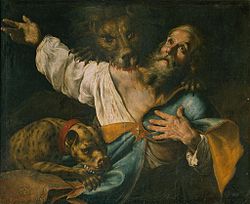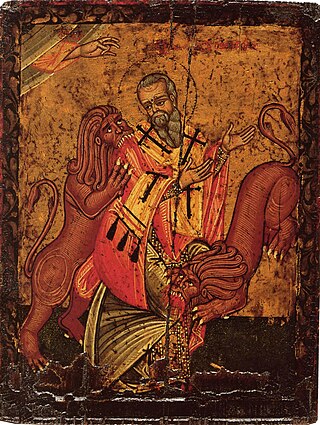
The word catholic comes from the Greek phrase καθόλου katholou 'on the whole, according to the whole, in general', and is a combination of the Greek words κατά 'about' and ὅλος 'whole'. The first known use of "Catholic" was by the church father Saint Ignatius of Antioch in his Letter to the Smyrnaeans. In the context of Christian ecclesiology, it has a rich history and several usages.

The Epistle to the Ephesians is the tenth book of the New Testament. According to its text, the letter was written by Paul the Apostle, an attribution that Christians traditionally accepted. However, starting in 1792, some scholars have claimed the letter is actually Deutero-Pauline, meaning that it is pseudepigrapha written in Paul's name by a later author strongly influenced by Paul's thought. According to one scholarly source, the letter was probably written "by a loyal disciple to sum up Paul's teaching and to apply it to a new situation fifteen to twenty-five years after the Apostle's death".
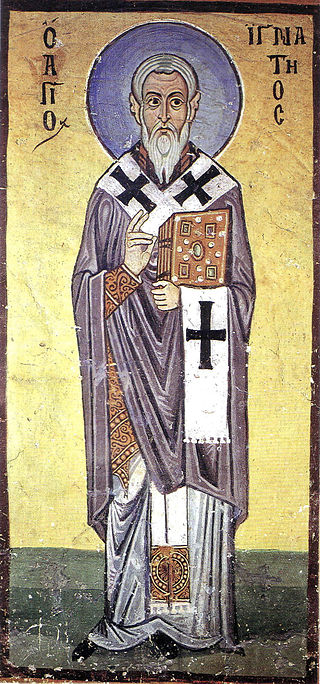
Ignatius of Antioch, also known as Ignatius Theophorus, was an early Christian writer and Patriarch of Antioch. While en route to Rome, where he met his martyrdom, Ignatius wrote a series of letters. This correspondence now forms a central part of a later collection of works known to be authored by the Apostolic Fathers. He is considered to be one of the three most important of these, together with Clement of Rome and Polycarp. His letters also serve as an example of early Christian theology. Important topics they address include ecclesiology, the sacraments, and the role of bishops.
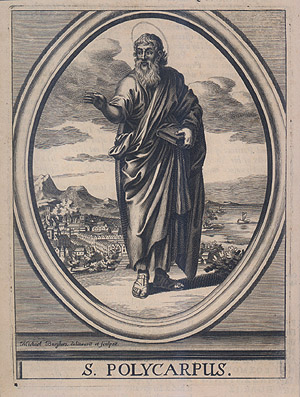
Polycarp was a Christian bishop of Smyrna. According to the Martyrdom of Polycarp, he died a martyr, bound and burned at the stake, then stabbed when the fire failed to consume his body. Polycarp is regarded as a saint and Church Father in the Catholic, Eastern Orthodox, Oriental Orthodox, Anglican, and Lutheran churches.
AD 68 (LXVIII) was a leap year starting on Friday of the Julian calendar. At the time, it was known as the Year of the Consulship of Silius Italicus and Trachalus, or the start of the Year of the Four Emperors. The denomination AD 68 for this year has been used since the early medieval period, when the Anno Domini calendar era became the prevalent method in Europe for naming years. These are now used throughout the world.
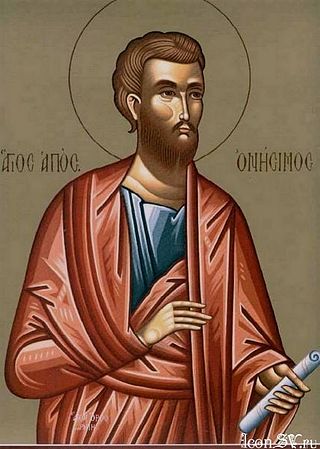
Onesimus, also called Onesimus of Byzantium and The Holy Apostle Onesimus in the Eastern Orthodox Church, was probably a slave to Philemon of Colossae, a man of Christian faith. He may also be the same Onesimus named by Ignatius of Antioch as bishop in Ephesus which would put Onesimus's death closer to 95. If so, Onesimus went from slave to brother to bishop.
The Apostolic Fathers, also known as the Ante-Nicene Fathers, were core Christian theologians among the Church Fathers who lived in the 1st and 2nd centuries AD who are believed to have personally known some of the Twelve Apostles or to have been significantly influenced by them. Their writings, though widely circulated in early Christianity, were not included in the canon of the New Testament. Many of the writings derive from the same time period and geographical location as other works of early Christian literature which came to be part of the New Testament.
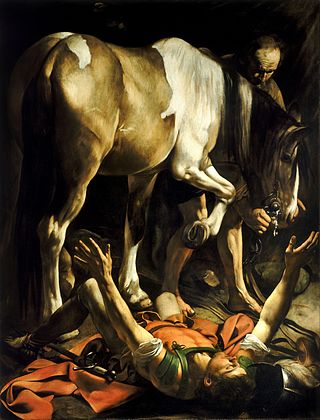
The Pauline epistles are the thirteen books in the New Testament traditionally attributed to Paul the Apostle.

The Acts of Barnabas is a non-canonical pseudepigraphical Christian work that claims to identify its author as John Mark, the companion of Paul the Apostle, as if writing an account of Barnabas, the Cypriot Jew who was a member of the earliest church of Jerusalem; through the services of Barnabas, the convert Saul was welcomed into the apostolic community. Three pseudepigraphical works are linked with the name of Barnabas: the Epistle of Barnabas, written between AD 70 and 135, this Acts and the medieval text Gospel of Barnabas. None of them have been accepted into the biblical canon.

The Epistle of Polycarp to the Philippians is an epistle attributed to Polycarp, an early bishop of Smyrna, and addressed to the early Christian church in Philippi. It is widely believed to be a composite of material written at two different times, in the first half of the second century. The epistle is described by Irenaeus as follows:

The Epistle of Ignatius to the Trallians is an epistle attributed to Ignatius, a second-century Bishop of Antioch and martyr, and addressed to the church in Tralles. It was written during the bishop's transport from Antioch to his execution in Rome.

The Epistle of Ignatius to the Smyrnaeans is an epistle from circa 110 A.D. attributed to Ignatius of Antioch, a second-century bishop of Antioch, addressed to the Early Christians in Smyrna.
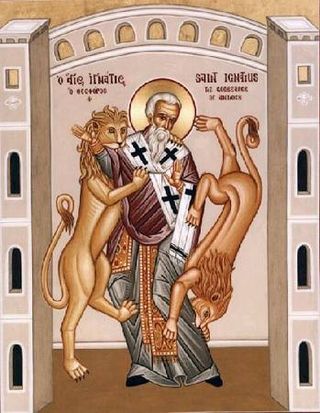
The term proto-orthodox Christianity or proto-orthodoxy describes the early Christian movement that was the precursor of Christian orthodoxy. It was coined by Bentley Layton, but is often erroneously attributed to New Testament scholar Bart D. Ehrman. Ehrman argues that this group from the moment it became prominent by the end of the third century, "stifled its opposition, it claimed that its views had always been the majority position and that its rivals were, and always had been, 'heretics', who willfully 'chose' to reject the 'true belief'." In contrast, Larry W. Hurtado argues that proto-orthodox Christianity is rooted in first-century Christianity.

The canon of the New Testament is the set of books many modern Christians regard as divinely inspired and constituting the New Testament of the Christian Bible. For historical Christians, canonization was based on whether the material was from authors socially approximate to the apostles and not based solely on divine inspiration – however, many modern scholars recognize that the New Testament texts were not written by apostles. For most, it is an agreed-upon list of 27 books that includes the canonical Gospels, Acts, letters attributed to various apostles, and Revelation, though there are many textual variations. The books of the canon of the New Testament were written before 120 AD. Although the list of what books constituted the canon differed among the hundreds of churches in antiquity, according to ancient church historian Eusebius there was a consensus that the same 27 books constituting the canon today were the same 27 books generally recognized in the first century. For the Orthodox, the recognition of these writings as authoritative was formalized in the Second Council of Trullan of 692. The Catholic Church provided a conciliar definition of its biblical canon in 382 at the (local) Council of Rome as well as at the Council of Trent of 1545, reaffirming the Canons of Florence of 1442 and North African Councils of 393–419. For the Church of England, it was made dogmatic on the Thirty-Nine Articles of 1563; for Calvinism, on the Westminster Confession of Faith of 1647.
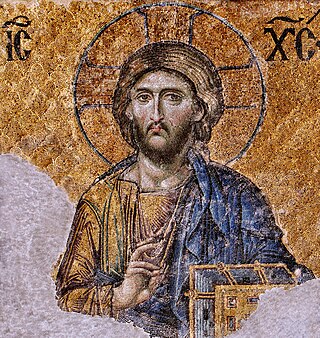
The Eastern Orthodox Church is opposed to the Roman Catholic doctrine of papal supremacy. While not denying that primacy does exist for the Bishop of Rome, Eastern Orthodox Christians argue that the tradition of Rome's primacy in the early Church was not equivalent to the current doctrine of supremacy.

The Epistle of Ignatius to the Romans is an epistle attributed to Ignatius of Antioch, a second-century bishop of Antioch. It was written during his transport from Antioch to his execution in Rome. To the Romans contains Ignatius’ most detailed explanation of his views on martyrdom.

The Epistle of Ignatius to the Magnesians is an epistle attributed to Ignatius of Antioch, a second-century bishop of Antioch, and addressed to the church in Magnesia on the Maeander. It was written during Ignatius' transport from Antioch to his execution in Rome.
Damas was Bishop of the church in Magnesia in August 117.

The Epistle of Ignatius to Polycarp is an epistle attributed to Ignatius of Antioch, a second-century bishop of Antioch, and addressed to Polycarp, the bishop of Smyrna. It was written during Ignatius' transport from Antioch to his execution in Rome.

The Epistle of Ignatius to the Philadelphians is an epistle attributed to Ignatius of Antioch, a second-century bishop of Antioch, and addressed to the church in Philadelphia of Asia Minor. It was written during Ignatius' transport from Antioch to his execution in Rome.
